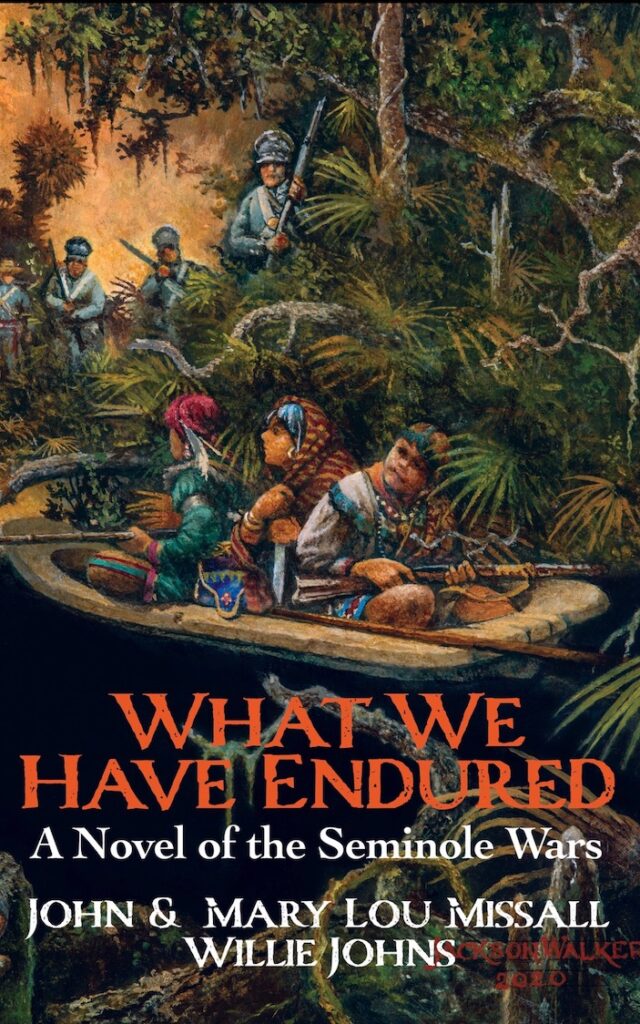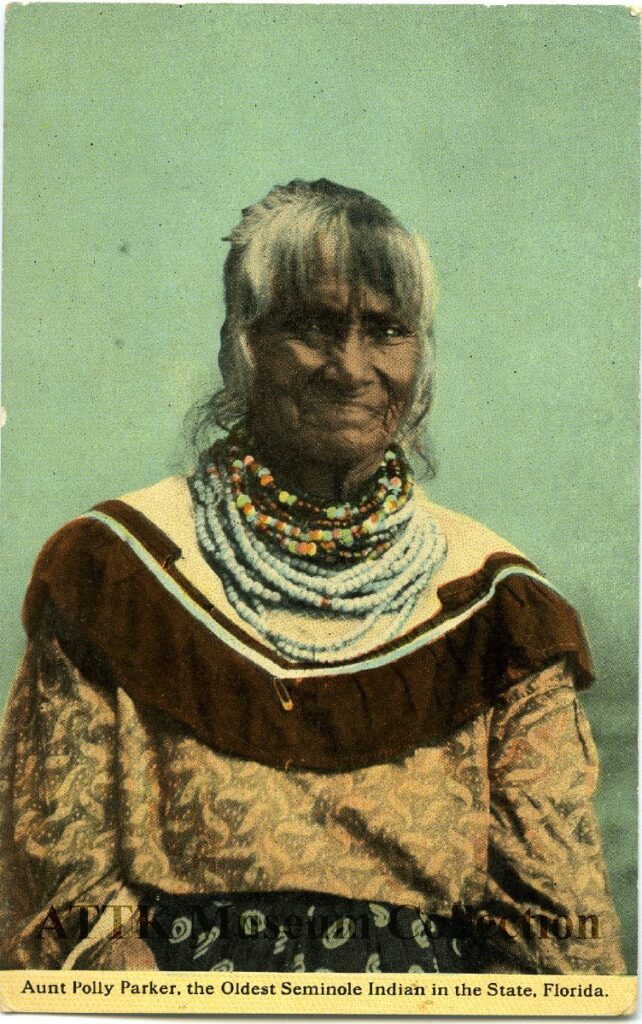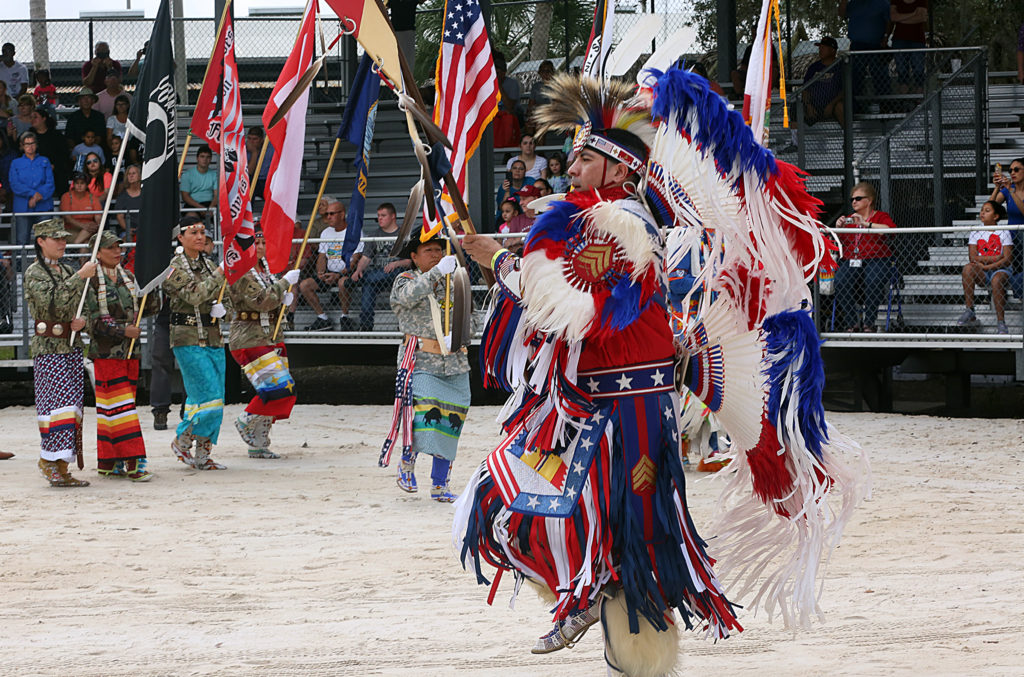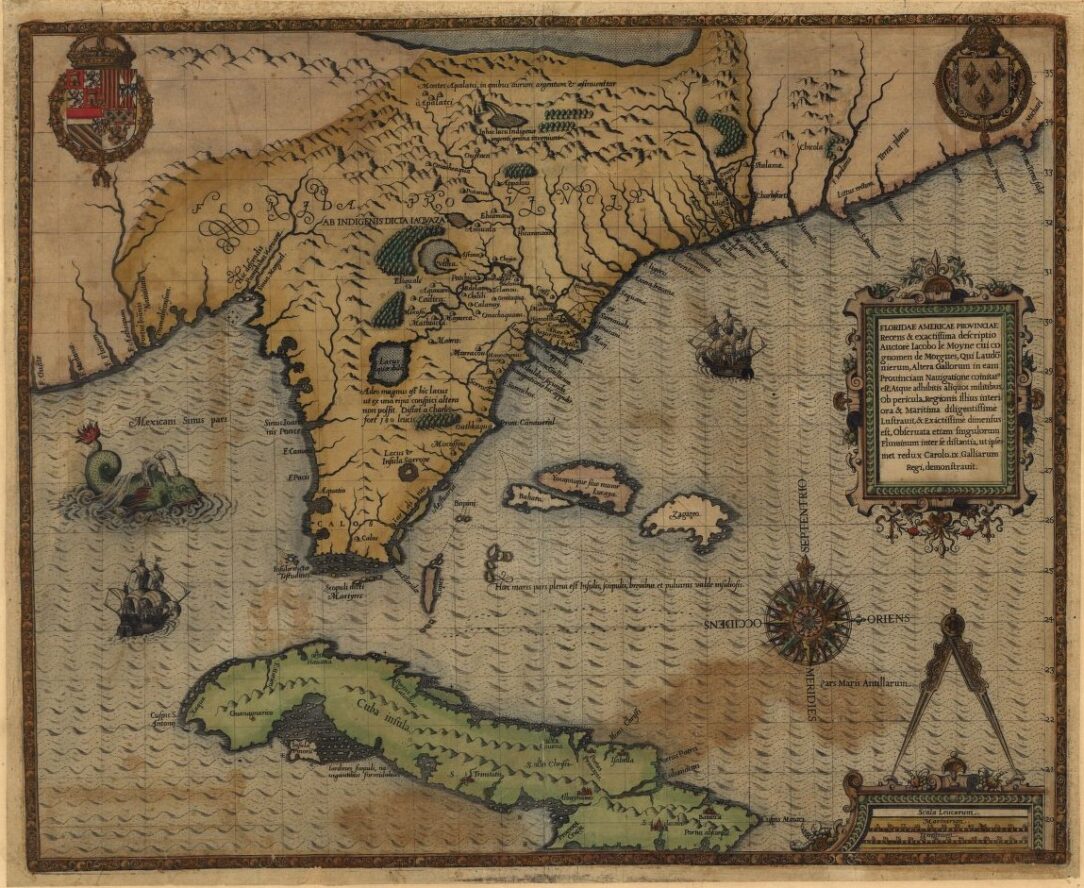
What We Have Endured by John and Mary Lou Missal and Willie Johns
Welcome back to the 2023 Summer book series! Last year, we explored two children’s books that were connected through the life and legends of Betty Mae Jumper. These two books celebrated Seminole legends, Seminole history and their ways of life, and traced the incredible life and legacy of Betty Mae. This year, we are shifting the focus to more adult literature featuring two very different options that feature Seminole representation.
Last month, we looked at A Land Remembered by Patrick D. Smith. This historic fiction novel spanned over a century of Florida history, and heavily featured Seminole representation. This month, we are looking as a distinctly different perspective. In What We Have Endured: A Novel of the Seminole Wars, the Seminole perspective during the Seminole War period is put at the center of the dialogue. While fictional, the novel is heavily rooted in historic fact, and many of the experiences, heartbreaks, and struggles did happen to Seminole people. In many ways, this novel bears witness to those experiences, and gives a voice to those whose voices have been lost to time.
What We Have Endured is about a brutal war period. Thus, many words, experiences, and circumstances may not be suitable for children. We encourage you to use discretion when deciding to read it, as there are disturbing and graphic scenes, as well as triggering topics throughout the book. Additionally, we will be discussing trends and events in the novel throughout the rest of the post. So, if you want to read the book with entirely fresh eyes, come back after you have completed it! While reading, we encourage you to contemplate and work through the discussion questions below.

Discussion Questions
- How does Aheedja change throughout the course of her life?
- Why does Aheedja tell Fugahee her story? Why is it important?
- In the introduction, the authors state that Aheedja is a fictional character who is “simply a substitute for all the Seminole who suffered so much.” (p. 3) Do you feel this is true? Why or why not?
- How does Aheedja endure in the face of continued tragedy?
- What does Aheedja means that her son Chalo was “always looking for something he could not find.” (p. 76) Why do you think Chalo made the decisions he did?
- How do Aheedja’s spirituality and visions help her? Do you think they helped her survive?
- What does Aheedja mean by “I was born an Alachua and now I am a Creek, but I will always be Seminole.”? (p. 14)
- Name 5 historically rooted events mentioned in the book. What did you know about them before? How are the western and Seminole perspectives different?
What We Have Endured: A Novel of the Seminole Wars by John and Mary Lou Missal & Willie Johns
Published in October 2020, What We Have Endured follows the heartbreaking life and struggles of the fictional Seminole woman Aheedja. The novel spans the entire Seminole war period and beyond, from 1812 to around 1890. The Seminole War period officially spanned from 1817 to 1858. But, the story follows Aheedja’s life and the impact of the wars, and not just what is written down in the history books.
The novel begins in 1890, when Aheedja is an old woman. Aheedja’s story about her life and the Long War is slowly revealed as she tells it to Fugahee, a young orphaned girl that has become like a great-granddaughter to her. At first Aheedja was hesitant to share her experiences, but after a dream she decides it is an important story to pass on to Fugahee. Aheedja tells Fugahee that “Our stories keep our people together. It is how we know who we are” (p.10).
Aheedja begins her tale in 1812, as a young girl in the Alachuan village of Cuscowilla. What follows is a devastating tale of loss, resilience, and survival that stretches over almost fifty years of Seminole history. Often, historians break the Seminole War period into three wars; the First, Second, and Third Seminole War. But, the reality is that for the Seminoles, there was only one, long war. For the Seminoles, it began in 1812, right where Aheedja’s story begins with the attack on Cuscowilla. Despite periods of reduced fighting, the Seminole were under constant pressure and threat during the entire War period. Within the novel, you can see that Aheedja and her family are constantly under threat of removal and violence. As she traces her life path with Fugahee, it parallels many of the important historic moments in the Seminole War period.

Chief Justice Willie Johns, via the Seminole Tribe
Former Chief Justice Willie Johns & John and Mary Lou Missal
What We Have Endured is co-authored by husband and wife John and Mary Lou Missal and the late Willie Johns. You can see Johns’ official portrait as Chief Justice above. Willie Johns was a celebrated Tribal historian and former Chief Justice of the Seminole Tribe of Florida. From the Brighton Reservation, he was part of the Wild Cat Clan.
John and Mary Lou Missal are award-winning authors who have extensively written about the Seminole War period. In the introduction to What We Have Endured, the authors wrote that the novel was “the result of a desire on the part of all three of us to tell the Native American side of the Seminole Wars.” (p. 2) As they have written about the Seminole War period in the past, the Missals also saw it as an “opportunity to address a shortcoming in their own works,” as often the Seminole War period is a “one-sided story” in the history books. (p. 2)
Aheedja’s character and some of her experiences are very loosely based on Johns’ great-grandmother. It was his way to “honor his great-grandmother, survivor of the wars, by telling the story of what she might have gone through.” (p. 2) Although it is not a direct retelling of her life, Johns strove to try and represent her, and other Seminoles who endured the War period, and their experiences. He was a member of the Florida Historical Society, as well as Tribal historian. Johns was committed to sharing the Seminole experience and perspective that often gets lost to history.
Seminole Representation and Historic Context
The intention behind What We Have Endured mirrors, in many ways, Johns’ goals and passions in his life: to share the Seminole story, Seminole history, and to educate on the Seminole perspective and experience. In an essay written for the FORUM, the state-wide magazine for the Florida Humanities Council in 2013, Johns in his own words stated how important this was to him. He writes “The past is very, very real to me. I am worried it could disappear unless we make a determined effort to preserve our history…. We are here to educate, not forgive. We are here to enlighten, not accuse.”
He goes on to touch on the controversies surrounding how to grapple with the atrocities of the past, stating that “I think education is the answer. Some Independents argue that the city of St. Augustine should tear down the old fort (Castillo de San Marcos) because of the atrocities that occurred to Indians there 400 years ago. I look at it differently. I would rather it remain standing so the memories of those days would not fade away. Those who don’t remember the past are doomed to repeat it.”
Previously in 2019, Johns organized a smaller walking tour of important historic Seminole sites in St. Augustine. In March 2020, Johns organized a nine-day road trip to visit several places that were important in Coacoochee, or Wild Cat’s life, from birth to death. Coacoochee’s escape from Fort Marion is prominently featured in What We Have Endured. In a Seminole Tribune article honoring Willie Johns, his sister Helene Buster noted that the publishing of What We Have Endured was a dream of his. “That was one of his life goals,” Buster said. “Between writing that book and Seminole history and cattle – he was the only independent cattle owner – those were three things always on the top of the list of things he wanted to accomplish. And he did.”
The Seminole Perspective
So, it makes sense that the authors rooted the novel not just in history, but history from the Seminole perspective. In What We Have Endured, Aheedja acts as a witness to the Seminole experience during the War period. By being present for some of the most bloody, devastating, and crucial parts of the Seminole War period, Aheedja bears witness to this history. She experiences loss, anger, triumph, and devastation only to continue moving forward and trying to survive.
In our featured image this week, you can see a fine art piece titled The Battle of Okeechobee, painted by Guy LaBree in 1983 (1990.4.2, ATTK Museum). In the novel, Aheedja recounts the battle for Fugahee, as her son Chalo and uncle fought there. The Battle of Okeechobee is only one of the major historic events that Aheedja experiences throughout the novel. By firmly rooting the novel in the historic reality of the Seminole War period, the authors can to the best of their ability give voice to the Seminole experience during this devastating war period.
Polly Parker’s Long Walk
In part, the character Aheedja is based on the incredible true story of Polly Parker. The US Army captured Parker outside Fisheating Creek in 1856, and transported her on the steamship Gray Cloud (Egmont Key 16). Bound for New Orleans, Parker and other captured Seminoles would travel up the Mississippi to join the Trail of Tears. In 1858, Billy Bowlegs, Parker, and 162 other captured Seminoles would be held at the internment camp at Egmont Key in the middle of Tampa Bay. Later, Parker would recall being held at gunpoint in the stockade (Egmont Key 14). In 2013, Johns spoke about Egmont Key during an event commemorating Parker’s life and escape. “It’s kind of like our Holocaust. Our people were held captive here because of a war that was going,” said Johns “It was against the law in those days after 1830 that Native people be east of the Mississippi.”

The Lighthouse on Egmont Key
The US Army then removed Parker and the others from Egmont Key to continue their long journey to the Trail of Tears. But, that would not be Parker’s story. When the Gray Cloud stopped at St. Marks to refuel, Parker was able to escape under the guise of gathering medicine. She would walk over three hundred miles home to Lake Okeechobee, and lead half a dozen other escaped Seminoles home. Below, you can see the only known photograph of Polly Parker. The caption reads “Aunt Polly Parker, the Oldest Seminole Indian in the State of Florida.”

2003.15.49, ATTK Museum
Aheedja’s Walk
In What We Have Endured, Aheedja follows Parker’s journey back home from St. Marks. She lives through the internment at Egmont Key, only to take the opportunity to escape when gathering medicine at St. Marks. Much like in other parts of the novel, Aheedja can give a voice to an important moment in Seminole history.
The last part of the novel in Aheedja’s voice is about her journey home. Along her walk, she traces back the events of the War, and the devastation that she felt. But, she continued on, saying “When people hear of my long walk, they ask how I could do it. Walking is easy, I tell them, especially if the burden you are carrying is light. I have walked many miles, all over Florida, sometimes with the heaviest burdens a person can carry, both on her back and in her heart. If it is for my people, I can always walk a few more.” (p. 269)
Honoring the Seminole Experience
Although many of the specific situations and main characters depicted in What We Have Endured are fictional, the authors rooted them in historic fact. Aheedja acts as a witness to history. In particular, she bears witness to the Seminole experience during the Long War. This is part of why it was so important to have her life encompass the totality of the Seminole War period.
For so long, the experiences, realities, and devastation of the Seminole War period centered the American perspective. Newspapers of the time center settler and trader perspectives. Letters and documentation between U.S. Army soldiers, generals, and powerful voices have long told the history. But, only from their perspective. Often throughout the book the authors italicize snippets of the flip side of the war, including generals and those in power. Thus, the authors place these perspectives into sharp contrast with Aheedja’s retelling. Aheedja thus becomes a conduit for the Seminole experience, which before had been relatively voiceless.
Aheedja’s path throughout the Seminole War period follows a number of important battles and events that impacted Seminole life and agency. She also saw unfathomable devastation, loss of family, pain, and heartbreak. But, Aheedja passed her story and resilience on to another. At the very end of the novel, Fugahee is now an old woman in 1958 on the Brighton Reservation. In the last moments of the book, Fugahee passes the story on again to her own great-grandson, stating “Come, Willie, sit down here and let me tell you about my Eckose (great-grandmother). It is time you learned about her and our people, and what we have endured.” (p. 270)
What We Have Endured is available for purchase digitally and in paperback, as well as through Kindle Unlimited.
Additional Sources
The author accessed these sources digitally. Page reference numbers may not align with paper and hardback copies.
Egmont Key: A Seminole Story. The Seminole Tribe of Florida Tribal Historic Preservation Office. https://stofthpo.com/wp-content/uploads/2022/08/Egmont-Key-Digital-book-web.pdf.
What We Have Endured: A Novel of the Seminole Wars. John Missal, Mary Lou Missal, and Willie Johns. The Florida Historical Society Press. 2020. Digital.
Author Bio
Originally from Washington state, Deanna Butler received her BA in Archaeological Sciences from the University of Washington in 2014. Deanna moved to South Florida in 2016. Soon, she began working for the Seminole Tribe of Florida’s Tribal Historic Preservation Office. Deanna was the THPO’s Archaeological Collections Assistant from 2017-2021. While at the THPO, Deanna worked to preserve, support, and process the Tribe’s archaeological collection. She often wrote the popular Artifact of the Month series, and worked on many community and educational outreach programs. She lives in Fort Myers, FL with her husband, son, and dog.



